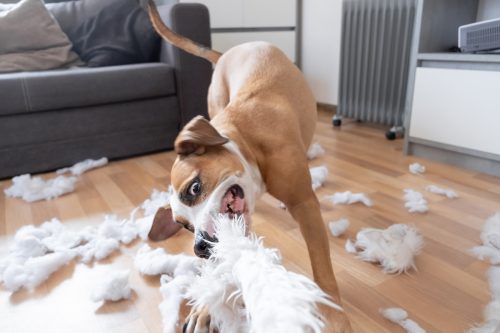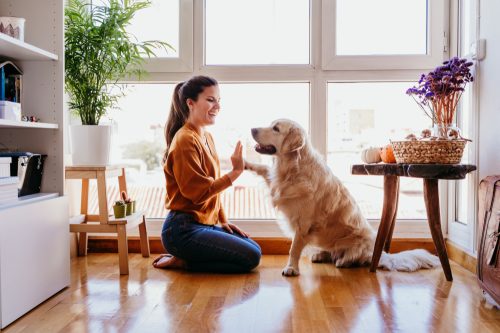7 Signs Your Dog Is Suffering From Separation Anxiety—And How to Overcome It

The idea of a dog standing by the door to greet their owner has long been a symbol of the bond between humans and pets. But in some instances, your dog may not simply be glad to see you but utterly relieved. Separation anxiety in dogs became much more common post-pandemic after people began returning to the workplace; some studies say dog separation anxiety increased over 700 percent between 2020 and 2022.
However, it doesn’t always take a huge life change to trigger your pup’s anxiety—and it may not always be related to being away from you. After all, there are many reasons why a dog may feel stressed, and they can’t exactly communicate what’s bothering them. To understand this issue better, we consulted veterinarians. Read on to learn the top indicators your dog is suffering from separation anxiety and what you can do to help them feel more at ease.
RELATED: Cesar Millan Says You Should Never Walk Behind Your Dog—Here’s Why.
This is why some dogs get anxious when left alone.

“All dogs are born with an array of survival instincts that can be classified as ‘respondent behaviors,’ meaning that they are inherent from birth and not a learned behavior,” explains Alexandra Bassett, CPDT-KA, lead trainer and behavior specialist at Dog Savvy Los Angeles.
One such involuntary response is the display of pack instincts. “Since survival in the wild dictates staying together at all costs, pack instincts compel a dog to keep an eye on you and follow you wherever you go—that’s why our dogs follow us from room to room,” says Bassett.
She notes that this is referred to as the “velcro dog.” Of course, when you’re not around your pet much at all, it can exacerbate this instinct.
It’s also important to understand that dogs with separation anxiety are truly struggling as opposed to other pets who may merely prefer you being home.
“Much like a human being having a severe panic attack, a dog with separation anxiety has difficulty calming down once the stress response kicks in,” says Bassett. “Your dog’s inability to cope and self-soothe is, therefore, partly biochemical.”
When a dog feels triggered, their limbic system can get activated. This is the “primal” side of the brain that is responsible for regulating emotions.
“Once the limbic system is active, mounting levels of frustration can result in elevated levels of cortisol flooding your dog’s bloodstream, making it difficult for them to calm down. This, in turn, can trigger the fight or flight response and the release of adrenaline, which further energizes your dog and escalates their distress,” explains Basset.
RELATED: The 10 Most High-Maintenance Dog Breeds, New Study Shows.
7 Signs Your Dog Has Separation Anxiety
1. They’re exhibiting destructive behavior.

Though separation anxiety can manifest in many ways, one of the most common indicators that experts point to is destructive behavior.
“This could include shredded furniture, broken blinds, chewed-on doors and baseboards, and even ripped-up carpet,” says Josh Snead, CEO of Rainwalk Pet Insurance.
But it’s important to realize that this behavior isn’t being done to punish you. “While people may exercise, chew on their nails or have a drink to relieve tension, dogs tend to chew, lick excessively, pace, or house-soil when anxious,” explains MSPCA–Angell.
2. They bark or howl excessively.

Perhaps the most obvious sign of dog separation anxiety is “excessive barking, whining, or howling when you leave your home,” says Melissa M. Brock, a board-certified veterinarian and author at Pango Pets.
3. They pace when you’re about to leave.

Animal instincts are no joke, so you may observe your dog’s anxious behavior before you’ve even left the house. Brock notes that they might start acting restless or pacing when they realize you’re about to go.
Bassett says to look for body language cues like a furrowed brow, ears pinned back, or a tucked tail.
“They may also either keep their eyes glued to you or stick by your heel as you move through your departure routine—like when you put on a pair of shoes, pick up a bag or jacket, or grab a pair of keys, just before walking out an exit door,” Bassett adds.
4. They drool or pant more than normal.

Lindsay Butzer, DVM, a popular veterinarian on social media and a PetMeds partner, notes that anxious dogs may exhibit physical symptoms, including “excessive drooling, panting, or salivation [or] increased heart and breathing rates.”
5. They go to the bathroom inside.

Brock adds that dogs suffering from separation anxiety may start “defecating or urinating indoors, even if they’re house-trained.”
6. They try to escape.

Both Brock and Butzer note that dogs may try to escape from the home, yard, or crate if they’re struggling with separation anxiety.
When you go out, be sure your yard is properly fenced in and the gate closed, and that all doors and windows are securely shut.
7. They begin self-harming.

In serious situations, an anxious dog may begin self-harming, says Butzer, who explains that this might look like “excessive licking or chewing on themselves causing skin lesions.”
In this case, seek veterinary care immediately.
How to Help a Dog With Separation Anxiety
Unless you get a work-from-home job, you’ll have to help your pooch manage their separation anxiety. A good first step is to actually see how their stress is manifesting.
“If you are unsure how your dog behaves once you are away from home, consider purchasing a security camera, baby monitor, or pet cam to see how they act in your absence,” advises Brock.
In this case, Bassett says to watch until 30-45 minutes after you’ve left. A delayed reaction can occur when a dog isn’t sure if you’ve just left for a quick errand or for a longer stretch.
Gradually introduce your dog to being alone.

If you are able to stay home, gradually introduce your dog to being alone.
“Practice leaving your dog alone for short periods of time, like going to get the mail or going to the garage. Start by only leaving for a few seconds and gradually increase the amount of time you are gone,” recommends Brock. “Dogs do not process time the same way humans do, so a minute away from your dog can feel the same for them as an hour away. This allows you to repetitively desensitize your dog to the process of you leaving.”
She also suggests going through the same routine as if you were leaving for a full day, such as grabbing your keys and purse.
During such a training exercise, Daniel Caughill, co-founder of The Dog Tale, advises against playing with your dog as soon as you get back.
“When you return, you can greet your pet, but try not to get them too excited… doing so can make their anxiety even worse as they anticipate your arrival,” he explains. “After a few moments, tell your pet to sit, and once they obey and calm down, praise them verbally and physically.”
Desensitize them to your leaving routine.

Your dog is likely smart enough to suss out what you do when you’re about to leave the house, which is why Butzer recommends trying to “desensitize your dog to your departure cues, such as picking up your keys or putting on your coat.”
“You can do this by performing these actions but not leaving the house. Over time, your dog will learn that these cues don’t always mean you’re leaving,” she points out.
Keep the television on while you’re out.

Courtnye Jackson, a veterinarian and founder of The Pets Digest, suggests turning the television or radio on before you leave, as the human voices may soothe your dog.
Play with them before leaving.

Jackson also recommends taking your dog for a walk or play session before leaving so they’re more tired and inclined to sleep while you’re out.
Use high-reward treats.

Butzer suggests a training method called counterconditioning, “which involves changing your dog’s emotional response to being alone.” She explains, “This could involve giving your dog a special treat or toy only when you’re gone.”
Or you can try giving your dog a “high-reward treat” when you return, says Brock: “This could be their favorite chew toy or a puzzle toy stuffed with dog treats or peanut butter. Your dog will slowly start to associate you leaving them alone with a reward.”
Use natural calming aids.

Most pet stores and online retailers are well-versed in dog separation anxiety and sell a variety of natural calming aids that can help relax your dog while you’re out.
Teresa Manucy, veterinarian at Chewy, suggests calming chewable treats but notes that you’ll want to get specific treats for small, medium, or large dog breeds.
Other options include calming toys, calming diffusers, and even special speakers that play calming sounds for dogs.
Consider crate training.

Crate training is another method recommended by almost all of the experts we consulted. There’s a common misconception that this is cruel, but “many dogs feel safe and secure inside of crates as it resembles a den-like environment,” explains Brock.
She says to start with short periods of time in the crate and then lengthen them. “Feed your dog all of its meals inside of the crate, and encourage your dog to sleep inside of its crate at night. Use treats to make the crate a positive experience and environment for your dog.”
You can also start with a crate, then move your dog to a designated room without the potential for destruction, and finally, graduate them to being allowed in the whole house.
Visit the veterinarian.

“It’s time to see a vet or seek professional help if your dog’s separation anxiety is severe, causing harm to themselves or significant damage to your home, or if your attempts to alleviate their anxiety aren’t working,” says Butzer.
“Many times, your regular vet will refer you to a behavioral veterinarian where you can further evaluate the dog’s actions,” shares Jackson. “A last resort for many vets is to place the dog on anti-anxiety medications.”